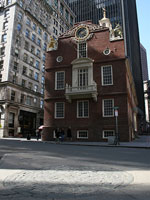At a Glance
Teacher Review
Topics
Website
Features
Duration
Grade(s)
Lesson Format
Download
The Boston Massacre: Fact, Fiction, or Bad Memory
Students attempt to assign responsibility for the Boston Massacre through careful reading of primary and secondary sources and consideration of such issues as who produced the evidence, when it was produced and why was it produced.
Review

With iconic historical events such as the Boston Massacre it can be difficult to separate historical fact from myth. This lesson acquaints students with some of the subtleties of constructing historical accounts. It allows them to see firsthand the role of point of view, motive for writing, and historical context in doing history. The lesson opens with an anticipatory activity that helps illustrate to students how unreliable memory can be, and how accounts of the past change over time. Students then analyze a set of three different accounts of the Boston Massacre: a first-hand recollection recorded 64 years after the fact, an account written by an historian in 1877, and an engraving made by Paul Revere shortly after the event. We especially like the fact that with the first document, the teacher models the cognitive process of analyzing the source information by engaging in a “think aloud” with the document. This provides a great opportunity to uncover for students the kinds of thoughts and questions with which an historian approaches an historical source. The primary source reading is challenging, and students will likely require significant additional scaffolding to understand the meaning of the texts. Teachers may want to consider pre-teaching some of the difficult vocabulary, excerpting or modifying the text, or perhaps reading the text dramatically together as a whole class.
Notes
In the lesson, Step 2 makes reference to a “Who’s to Blame” graphic organizer. This organizer is not currently included on the website; teachers will want to provide some other means for students to record and organize their ideas.
| Field | Criteria | Comments | ||
|---|---|---|---|---|
| Historical Content | Is historically accurate? | Yes |
||
| Includes historical background? | Yes |
|||
| Requires students to read and write? | Yes |
|||
| Analytic Thinking | Requires students to analyze or construct interpretations using evidence? | Yes |
||
| Requires close reading and attention to source information? | Yes |
|||
| Scaffolding | Is appropriate for stated audience? | Yes |
||
| Includes materials and strategies for scaffolding and supporting student thinking? | No |
|||
| Lesson Structure | Includes assessment criteria and strategies that focus on historical understanding? | Yes |
||
| Defines clear learning goals and progresses logically? | Yes |
|||
| Includes clear directions and is realistic in normal classroom settings? | Yes |
|||